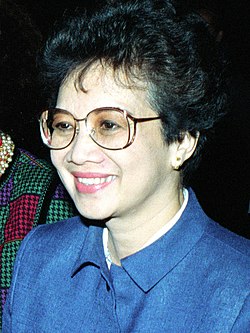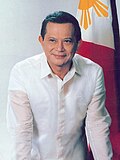After being dared by an American journalist, President Ferdinand E. Marcos declared a snap election during an interview on the ABC political affairs program, This Week with David Brinkley in November 1985. [3] [4] [5] On December 3, the Batasang Pambansa (National Assembly) passed a law setting the date of the election on February 7, 1986. [6] On February 4, 1986, Marcos declared February 6 and 7 as nationwide non-working special public holidays to "give all registered voters fullest opportunity to exercise their right of suffrage." [7]
The courage and the essential goodness of Corazón Aquino was so impressive in her battle against enormous odds. And the bravery of her followers— many of whom were killed as they pursued their belief in a true democracy... And then there was this: the role of the press, print and electronic. Through television cameras and newspapers, the whole world was watching. President Marcos could lie and cheat, but in the end he could not hide. [8]
The assassination of Senator Benigno "Ninoy" Aquino Jr. on August 21, 1983, revived the oppositionist press, and the pro-Marcos press soon retaliated. Both catered to the intense news-hunger of the Filipino people, but it was a smaller group of reporters who delivered the crucial blow to Marcos' image, with reports about Marcos' hidden wealth and falsified war record. An example would be the article written by Eduardo Lachica in December 1982 that stirred interest after it had been published in The Asian Wall Street Journal on the Marcos property holdings in New York. [8]
By late January 1985, the pursuit for the truth behind the rumors began with Lewis M. Simons, a Tokyo-based correspondent for the San Jose Mercury News , who sent a memo to his desk editor, Jonathan Krim. There had been incessant speculations of Philippine "capital flight" that not only involved Ferdinand and Imelda Marcos themselves, but also government officials and friends of the first family. Simons provided Krim with a list of names, telling him to look into Philippine investments in the San Francisco Bay area. Krim handed over several clips (including Lachica's article) and miscellaneous letters from the Filipino exile community to the investigative reporter attached with a note, "Look into this." Carey began his paper trail after setting up his personal computer and a telephone modem as well as using real-estate data bases to acquire both California and out-of-state records. Another method he used in tracking the story were his interviews with the members of the Filipino exiled opposition who were divided between those who were resolute in helping him and those who deemed themselves apolitical, fearing reprisals if they spoke. In an interview, Carey says, "I kept telling them, 'I'm not interested in quoting people, I'm not going to use yours or any names. I'm interested in documentary evidence,' That convinced people...." Due to budgetary concerns, he continued his trail by exploring records in New York and Chicago through telephone. At a later date, Katherine Ellison from the San Francisco Bureau, who Carey called a "great investigative reporter," joined the group as they conducted interviews and convinced reluctant locals to provide essential information. [8]
On June 23–25, 1985, the Mercury News series under the by-lines of Carey, Ellison, and Simons elicited a staggering response after revealing a list of names, showing how the Filipino elite had illegally invested millions in the U.S., why real estate conditions made California a prime investment territory, and how capital flight fueled Philippine insurgency. Meanwhile, local publications in the Philippines such as Malaya, Veritas, Business Day, and Mr. and Mrs. all reprinted the series. There were protests on the streets, attempts by the National Assembly's opposition minority to file an impeachment hearing (which was quickly annulled) while Marcos was forced to order an impartial inquiry (though it lasted briefly). [8]
The international clamor surprised the three Mercury News investigators with Carey commenting, "There's a vast difference between simple allegations and something with a factual, documentary basis," he says. "It provokes a totally different psychological reaction in the readers. Gossip stirs their apathy; facts galvanize them to action." [8]
After the successful publication of the series, newer articles were produced by the Mercury News team, among other things, such as how the Manila elitists smuggled fortunes, in the form of American currency, out of the country. More reporters from The Washington Post , The Wall Street Journal , and The New York Times developed other angles as well. The most significant were those uncovered by Times' Jeff Gerth, who wrote on the misuse of American aid money by the Marcos' administration. Although Marcos continued to deny these allegations, that did little to avert the consequences. His support in the congress quickly dissipated while news of his misrule endangered U.S. military interests. [8] Revelations of Marcos' hidden wealth disparaged him in America, but in the Philippines, it was the truth of his war records that proved the most damaging to his reputation.
Organizing the 1986 Philippine elections
On November 4, 1985, Sam Donaldson and George Will interviewed President Marcos on the American Broadcasting Company political affairs program This Week with David Brinkley . [3] [4] Marcos was being asked about his policies and support when, without warning, he announced that he would hold a snap election on February 7, 1986, a year earlier than the supposed 1987 election. Marcos said that in the snap election, the vice president would also be determined. Also, the final decision regarding the election would be determined by the National Assembly. On December 3, 1985, the Batasang Pambansa passed a law setting the date of the election on February 7, 1986. [6]
Marcos declared the early elections since he believed that this would solidify the support of United States, silence the protests and criticisms both in the Philippines and the United States, and finally put the issues regarding the death of Benigno Aquino Jr. to rest. [9]
The opposition saw two problems regarding the announcement of Marcos. First is the credibility of the announcement since at the time two-thirds of the National Assembly were from Kilusang Bagong Lipunan, which means that they could decide not to push through with the snap election. This would then give Marcos an image that he was willing to entertain opposition, which would then contribute to his popularity. Second problem is that the opposition was yet to choose a single presidential candidate to who had a chance to win. [9] This posed a problem for them since the opposition were yet to be united, supporting only one presidential candidate.
The opposition, was divided between the widow of Benigno Aquino Jr., Corazon "Cory" Aquino, and Doy Laurel, son of President Jose P. Laurel. Cardinal Jaime Sin talked to both the potential candidates. Aquino was hesitant to run since she believed that she was not the best and most able choice. Aquino said she would be willing to run if there was a petition campaign with at least a million signatures supporting her as a presidential candidate. Doy on the other hand, was earnest in running as president since he believed his family background, training, and experience had prepared him for the presidency.








